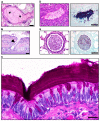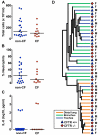Cystic fibrosis pigs develop lung disease and exhibit defective bacterial eradication at birth
- PMID: 20427821
- PMCID: PMC2889616
- DOI: 10.1126/scitranslmed.3000928
Cystic fibrosis pigs develop lung disease and exhibit defective bacterial eradication at birth
Abstract
Lung disease causes most of the morbidity and mortality in cystic fibrosis (CF). Understanding the pathogenesis of this disease has been hindered, however, by the lack of an animal model with characteristic features of CF. To overcome this problem, we recently generated pigs with mutated CFTR genes. We now report that, within months of birth, CF pigs spontaneously developed hallmark features of CF lung disease, including airway inflammation, remodeling, mucus accumulation, and infection. Their lungs contained multiple bacterial species, suggesting that the lungs of CF pigs have a host defense defect against a wide spectrum of bacteria. In humans, the temporal and causal relations between inflammation and infection have remained uncertain. To investigate these processes, we studied newborn pigs. Their lungs showed no inflammation but were less often sterile than controls. Moreover, after introduction of bacteria into their lungs, pigs with CF failed to eradicate bacteria as effectively as wild-type pigs. These results suggest that impaired bacterial elimination is the pathogenic event that initiates a cascade of inflammation and pathology in CF lungs. Our finding that pigs with CF have a host defense defect against bacteria within hours of birth provides an opportunity to further investigate CF pathogenesis and to test therapeutic and preventive strategies that could be deployed before secondary consequences develop.
Figures







References
-
- Riordan JR, et al. Identification of the cystic fibrosis gene: cloning and characterization of complementary DNA. Science. 1989;245:1066–1073. - PubMed
-
- Welsh MJ, Ramsey BW, Accurso F, Cutting GR. Cystic Fibrosis. In: Scriver CR, et al., editors. The Metabolic and Molecular Basis of Inherited Disease. McGraw-Hill; New York: 2001. pp. 5121–5189.
-
- Quinton P. Physiological basis of cystic fibrosis: a historical perspective. Physiol. Rev. 1999;79(Suppl. 1):S3–S22. - PubMed
-
- Rowe SM, Miller S, Sorscher EJ. Cystic fibrosis. N. Engl. J. Med. 2005;352(19):1992–2001. - PubMed
-
- Guggino WB. Cystic fibrosis and the salt controversy. Cell. 1999;96(5):607–610. - PubMed
Publication types
MeSH terms
Grants and funding
LinkOut - more resources
Full Text Sources
Other Literature Sources
Medical
Molecular Biology Databases

